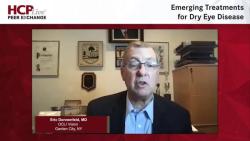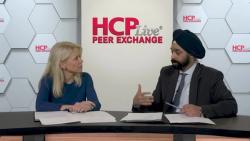Advances in the Management and Treatment of Dry Eye Disease - Episode 1
Dry Eye Disease Overview
Ophthalmologist experts provide an overview of dry eye disease.
Kendall Donaldson, MD, MS: Hello and welcome to this HCPLive® Peer Exchange titled, “Advances in the Management and Treatment of Dry Eye Disease.” My name is Dr Kendall Donaldson. I’m a professor of clinical ophthalmology. I practice cornea external disease and refractive cataract surgery at the Bascom Palmer Eye Institute [Plantation, Florida], where I’m the medical director of Bascom Palmer implantation. I am privileged to be here with my wonderful co-moderator, Paul.
I. Paul Singh, MD: Hi Kendall, hi everybody. How are you doing? My name is Paul Singh. I’m the president of the Eye Centers of Racine and Kenosha [in Wisconsin]. More importantly, I’m a confused glaucoma [specialist].
Kendall Donaldson, MD, MS: You need some help.
I. Paul Singh, MD: I treat a lot of glaucoma, butI always need help. I do a lot of anterior segment and cataract refractive [surgery] as well. I’m a [Wisconsin] Cheesehead as well. Thank you again for joining us, and I’m really excited to introduce our colleagues who are online today with us. I’m going to start with our good friend Laura Periman. Hi, Laura.
Laura Periman, MD: Hi. Thanks for the invitation to be here. I’m Laura Periman from Seattle, Washington, with the Space Needle in the background. I’m the founder and director of dry eye services and clinical research at the Periman Eye Institute.
I. Paul Singh, MD: Awesome. It’s great to have you here, of course. We have Brandon Ayres here as well.
Brandon Ayres, MD: Hi guys, thank you so much for having me. I am a cornea and anterior segment specialist in Philadelphia [Pennsylvania] based out of Wills Eye Hospital. I’m also part of the fellowship program at Wills Eye Hospital. I’m super happy to be here with you guys today.
I. Paul Singh, MD: Last but not least, a guy you’ve probably heard his name before, in New York, the one and only Eric Donnenfeld.
Eric Donnenfeld, MD: What a great group to be with tonight. I’m Eric Donnenfeld here from New York. I’m a clinical professor of ophthalmology at NYU [New York University], I’m a trustee of Dartmouth Medical School, and I love what we’re talking about today.
Kendall Donaldson, MD, MS: Paul and I feel very privileged to be here with this wonderful group. Our discussion today will focus on several topics pertaining to dry eye disease, including the challenges of unmet needs, current and emerging treatment options, and tailoring treatment strategies based on individual patient factors. Welcome everyone, and let’s get started.
We wanted to start with a disease overview. Basically, how is dry eye defined, what are the main common causes of dry eye, and how that presents in your practice. I’d like to open it up to my co-moderator, Paul.
I. Paul Singh, MD: The glaucoma specialist tells us what dry eye is all about.
Kendall Donaldson, MD, MS: I know you create a lot of dry eye, but hopefully you recognize it as well.
I. Paul Singh, MD: We try to help our cornea and anterior segment surgeons, exactly. It’s interesting. If you think about the definition of dry eye, it’s gone through some changes over the last few decades. I think the key factor, No. 1 for me, is that it is a disease. It’s a multifactorial disease, and I think it sounds obvious, but to state that this is a disease vs just a symptom, I think it’s crucial. It’s a disease that progresses. No. 2, it’s a disease of the homeostasis of the tear film. It’s a disruption to the natural, beautiful homeostasis of a tear film, which then can lead to symptoms that we face for a lot of our patients, whether it’s tearing, burning, pain, redness, photophobia, fluctuating vision as well.
If you think about some of the reasons why and some of the etiologies behind it, high osmolarity is one of them. We see that as No. 1. No. 2, we also see inflammation as a big component of the etiology for that as well. And there’s a disruption to the neurofeedback; the neurofeedback is what we think is also being affected. The definition is tear film instability caused by a number of those other problems and a disease that is multifactorial in nature.
Kendall Donaldson, MD, MS: One of the interesting things about dry eye is that it was unrecognized. I know in my training 20 years ago, we didn’t even talk about dry eye. Just over the last 10 years or so, we’re noticing it much more, and now that we have treatment options, we have more things that can help our patients. All of these symptoms that they’ve been having for years now are more defined, and we can fit them into this category of dry eye. We have so many different options to be able to help these patients. Eric, you were going to mention something?
Eric Donnenfeld, MD: Kendall, I was going to further what you said, and that is that 20 years ago, no one talked about dry eye. As the elder statesman here of this group, I can say unequivocally that 20 years ago, dry eye was like the back pain of ophthalmology. It was that disease no one wanted to take care of because there was no cure, you really couldn’t do anything for it. And now we understand it’s probably the single most common reason patients come into our offices. The great news is that over the last decade or two we’ve developed a lot of good therapies to improve dry eye. Dry eye, for me, is the tear film, and it’s where vision starts. Quality of vision starts with a good tear film. Without a good tear film, everything we do as ophthalmologists is degraded. I’ll turn it over to Laura to give a bit more information on that.
Kendall Donaldson, MD, MS: Laura’s practice concentrates on dry eye 100% of the time, right Laura, would you say?
Laura Periman, MD: All we do is ocular surface disease management and that expert tailored approach to dry eye disease. I’m learning so much all the time, even though this is all I do all the time, I’m still uncovering these little nuggets, little pearls, little subtypes that need to be addressed. I identify all the comorbidities I possibly can, and adjust where I possibly can. But to your point earlier, I agree wholeheartedly [with] that definition of hyperosmolarity, inflammation, desiccating stress, damage, disturbances in vision, loss of homeostasis, and that neurosensory compromise. Those are all targets in our approach to ocular surface disease, dry eye disease.
Kendall Donaldson, MD, MS: Great points. And Brandon, Eric mentioned how the ocular surface is the main refractive surface of the eye. I know you do a lot of very complex surgery and a lot of cataract surgery. Maybe you could comment on how this affects your surgical outcomes.
Brandon Ayres, MD: It’s funny, I remember as a resident sitting and listening to grand rounds, and we heard one of the first presentations when cyclosporine 0.05% finally got approved for treating dry eye. As a resident, I didn’t realize what a pivotal point that was, the first time we had a prescription medication to treat dry eye. Now even with all of the amazing things that we can treat and all the technology and the time we put into surgery, and reconstructing or repairing somebody’s eye, in the end, it doesn’t matter if they can’t see. And in these patients with complex ocular histories and complex surgeries we still end up focusing on the ocular surface because if the tear film’s no good, then the cornea’s no good, the surgery’s no good, and the patients aren’t happy. So the cornea wins the race, it rules the roost. You’ve got to watch out for dry eye.
I. Paul Singh, MD: For me as the glaucoma [specialist] here, I will say that we’ve seen a significant impact in compliance with glaucoma medication, glaucoma therapy, follow-ups…or even early glaucoma. If you look at studies on ocular surface in the tear film, SPK [superficial punctate keratitis] centrally, you have a significant reduction of contrast. You combine loss of contrast from dry eye, loss of contrast from glaucoma, and you have symptomology, where all the patients care about is their symptoms, not their [intraocular] pressure. We [tell them] your pressure’s 12 mm HG, that’s great. But they’re like, “I can’t see doctor,” [so it] doesn’t matter.
Eric made a good point, we finally have therapies that we can utilize early that can make a difference. Before we had those options, I don’t think we had the ability to treat them with more than artificial tears for many years. Now that we have those therapies, I think we’re seeing the impacts, and it’s kind of a vicious cycle there as well.
Kendall Donaldson, MD, MS: Thank goodness we are recognizing these symptoms, acknowledging those symptoms with the patients, and then offering them treatments.
TRANSCRIPT EDITED FOR CLARITY



